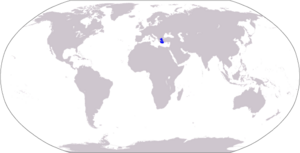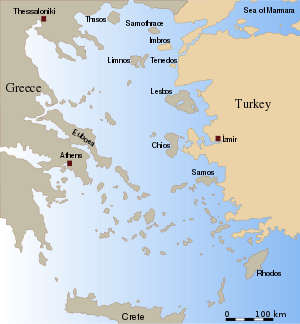Aegean Sea

| |
|---|---|

|
The Aegean Sea (Greek: Αιγαίο Πέλαγος([Aigaío Pélagos] ); Turkish: Ege Denizi, Adalar Denizi) is an elongated embayment of the Mediterranean Sea located between the southern Balkan and Anatolian peninsulas, i.e., between the mainlands of Greece and Turkey respectively. In the north, it is connected to the Marmara Sea and Black Sea by the Dardanelles and Bosporus. The Aegean Islands are within the sea and some bound it on its southern periphery, including Crete and Rhodes. The Aegean Region consists of nine provinces in southwestern Turkey, in part bordering on the Aegean sea.
The sea was traditionally known as Archipelago (in Greek, Αρχιπέλαγος), the general sense of which has since changed to refer to the Aegean Islands and, generally, to any island group because the Aegean Sea is remarkable for its large number of islands.
Etymology
In ancient times there were various explanations for the name Aegean. It was said to have been named after the Greek town of Aegae, or after Aegea, a queen of the Amazons who died in the sea, or Aigaion, the "sea goat", another name of Briareus, one of the archaic Hecatonchires, or, especially among the Athenians, Aegeus, the father of Theseus, who drowned himself in the sea when he thought his son had died.
A possible etymology is a derivation from the Greek word αἶγες – aiges = "waves" (Hesychius of Alexandria; metaphorical use of αἴξ (aix) "goat"), hence "wavy sea", cf. also αἰγιαλός (aigialos) "coast".
In the Bulgarian language the sea is also known as White sea (Бяло море). According to legend, Bulgarian sailors and merchants in the Middle Ages found it a hospitable and timid sea to travel and called it White sea in contrast to the hostile and dangerous Black sea.
History
"Aegean civilization" is a general term for the Bronze Age civilizations that developed in Greece and the basin of the Aegean sea between 3000-1200 B.C.E. While ancient Greek writers recounted stories of heroes, little was actually known about the Aegean civilization until the late nineteenth century.
In ancient times the sea was the birthplace of two ancient civilizations - the Minoans of Crete and the Mycenean Civilization of the Peloponnese.[1] Later arose the city-states of Athens and Sparta among many others that constituted the Athenian Empire and Hellenic Civilization. In other words, there were three distinct regions covered by the term, Aegean Civilization: Crete, the Cyclades and the Greek mainland. Crete is associated with the Minoan civilization from the Early Bronze Age, while the Cyclades and the mainland have distinct cultures. The Cyclades converged with the mainland during the Early Helladic ("Minyan") period and with Crete in the Middle Minoan period. From around 1450, the Greek Mycenaean civilization spread to Crete. Crete may have acted as a cultural bridge, since the culture and civilizations that evolved there appear to have engaged in commerce with a number of different centers, such as Ancient Egypt and the Middle East.
The Aegean region was later invaded by the Persians and the Romans, and inhabited by the Byzantine Empire, the Venetians, the Seljuk Turks, and the Ottoman Empire. The Aegean was the site of the original democracies, and its seaways were the means of contact among several diverse civilizations of the Eastern Mediterranean.
Hydrographic and Hydrochemical Setting

Aegean surface water circulates in a counter-clockwise gyre, with hypersaline Mediterranean water moving northward along the west coast of Turkey, before being displaced by less dense Black Sea outflow. The dense Mediterranean water sinks below the Black Sea inflow to a depth of 23-30m, then flows through the Dardanelles Strait and into the Marmara Sea at velocities of 5-15 cm/s. The Black Sea outflow moves westward along the northern Aegean Sea, then flows southwards along the east coast of Greece[2].
The physical oceanography of the Aegean Sea is controlled mainly by the regional climate, the fresh water discharge from major rivers draining southeastern Europe, and the seasonal variations in the Black Sea surface water outflow through the Dardanelles Strait.
Analysis[3] of the Aegean during 1991 and 1992 revealed 3 distinct water masses:
- Aegean Sea Surface Water - 40-50 m thick veneer, with summer temperatures of 21-26°C and winter temperatures ranging from 10°C in the north to 16°C in the south.
- Aegean Sea Intermediate Water - Aegean Sea Intermediate Water extends from 40-50 m to 200-300 m with temperatures ranging from 11-18°C.
- Aegean Sea Bottom Water - occurring at depths below 200-300 m with a very uniform temperature (13-14°C) and salinity (39.1-39.2 percent).
Notes
- ↑ Cullen, Tracey. 2001. Aegean prehistory: a review. American journal of archaeology, 1. Boston: Archaeological Institute of America.
- ↑ Aksu, A. E., D. Yasar, P. J. Mudie, and H. Gillespie. 1995. "Late glacial-Holocene paleoclimatic and paleoceanographic evolution of the Aegean Sea: micropaleontological and stable isotopic evidence". MARINE MICROPALAEONTOLOGY. 25(1): 1-28.
- ↑ Yagar, D., 1994. Late glacial-Holocene evolution of the Aegean Sea. Ph.D. Thesis, Inst. Mar. Sci. Technol., Dokuz Eyltil Univ., 329 pp. (Unpubl.)
ReferencesISBN links support NWE through referral fees
- Kormondy, Edward John. 1965. Readings in ecology. Prentice-Hall biological science series. Englewood Cliffs, N.J.: Prentice-Hall.
- Miller, Helen Hill. 1967. Bridge to Asia; the Greeks in the eastern Mediterranean. New York: Scribner.
- Sansal, Burak. Seas of Turkey All About Turkey. Retrieved October 28, 2008.
- United States. 2006. Aegean Sea Region. Washington, D.C.: Central Intelligence Agency.
Coordinates:
Credits
New World Encyclopedia writers and editors rewrote and completed the Wikipedia article in accordance with New World Encyclopedia standards. This article abides by terms of the Creative Commons CC-by-sa 3.0 License (CC-by-sa), which may be used and disseminated with proper attribution. Credit is due under the terms of this license that can reference both the New World Encyclopedia contributors and the selfless volunteer contributors of the Wikimedia Foundation. To cite this article click here for a list of acceptable citing formats.The history of earlier contributions by wikipedians is accessible to researchers here:
The history of this article since it was imported to New World Encyclopedia:
Note: Some restrictions may apply to use of individual images which are separately licensed.
